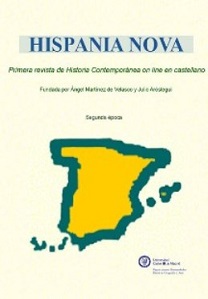Dreams of skin and celluloid
Representing the female body in Spanish Film Magazines during the 1930s
Abstract
During the interwar period, the main Western nations must redefine their visual culture by managing concepts such as modern human being, the body, or the technology. Mass media took then a decisive role, globalizing ideas, symbols and prototypes that were often focused on the female body. The unstoppable success of cinema -mainly, that one from Hollywood- had a key role in all that process, creating various types of women that were emulated by a large part of the society. In this essay we analyze, through the best Spanish film magazines of the 1930s, many dimensions of this process, such as the quest for a new ideal of beauty, the freedom of expression against censorship, the male look at the woman and her struggle to break the chains of the past.
Downloads
References
Armstrong, Tim. Modernism, Technology and the Body. New Haven, Cambridge U. P., 1998.
Ayala, Francisco. Indagación del cinema. Madrid: Mundo Latino, 1929.
Balázs, Béla. El hombre visible, o la cultura del cine. Buenos Aires: Cuenco de plata, 2000.
Black, Gregory D. Hollywood censored. Morality, Codes, Catholics and the Movies. New Haven: Cambridge U. P., 1994.
Bonet, Eugeni y Palacio, Manuel. Práctica fílmica y vanguardia artística en España (1925-1981). Madrid: Editorial Complutense, 1983.
Díaz Plaja, Guillermo. Una cultura del cinema. Introducció a una estètica del film. Barcelona: Publicacions de La Revista, 1930.
Doherty, Thomas. Pre-Code Hollywood. Sex, Immorality and Insurrection in American Cinema 1930-1934. New York: Columbia U. P., 1999.
González, Palmira. “La crítica cinematográfica en la primera etapa de la revista barcelonesa El Mirador (1929-1930)”, en Las vanguardias artísticas en la historia del cine español, actas del tercer Congreso de AEHC (San Sebastián: Euskaldiko Filmaltegia, 1991, pp. 309-351).
Gubern, Román. Proyector de luna. La generación del 27 y el cine. Barcelona: Anagrama, 1999.
Haiken. Elizabeth. Venus Envy. A history of Cosmetic Surgery. Baltimore: The Johns Hopkins University Press, 1997.
Hernández Eguiluz, Aitor. Testimonio en huecograbado. El cine en la 2ª república y su prensa especializada (1930-1939). Valencia: Ediciones de la Filmoteca, 2009.
Latorre, Jorge, Llano, Rafael y Martínez-Illán, Antonio. “Recepción del cine soviético en España: una historia entre guerras, censuras y aperturas”, Anagramas. Rumbos y sentidos de la comunicación, 9, 17, 2010, pp. 93-106.
Nicholas, Jane. The Modern Girl. Feminine Modernities, the Body and Commodities in the 1920s. Toronto: University of Toronto Press, 2015.
Martínez-Bretón, Juan Antonio. Libertad de expresión cinematográfica durante la II República Española (1931-1936). Madrid: Fragua, 2000.
Morris, Brian C.. La acogedora oscuridad. El cine y los escritores españoles (1920-1936). Córdoba: Filmoteca y Junta de Andalucía, 1993.
Pitarch, Daniel (ed.). Walter Benjamin. Escritos sobre cine. Madrid: Abada, 2017.
Pollard, Tom. Sex and violence. The Hollywood Censorship Wars. London: Paradigm, 1999.
Rucabado, Ramón. Bandera d’escàndol. Resum de la campany contra l’Exposició del Nu. Barcelona: Políglota, 1934.
Simon, Linda. Lost girls. The invention of the flapper. Waterside: Reaktion Books, 2017.
Tropiano, Stephen. Obscene, Indecent, Immoral and Offensive. 100 + years of censored, banned and controversial films. New York: Limelight, 2009.
Zeitz, Joshua. Flapper. A Madcap Story of Sex, Style, Celebrity and the Women who made America modern. New York: Crown Publishers, 2006.
Zubiaurre, Maite. Cultures of the Erotic in Spain 1898-1938. Nashville: Vanderbilt University Press, 2012.
HISPANIA NOVA is a journal duly registered, with ISSN 1138-7319 and legal deposit M 9472-1998.
The texts published in this journal - unless specifically stated- are licensed under a Creative Commons Attribution-Non Commercial-No derivative Works 3.0 Spain license. They can be copied, distributed and publicly communicated as long as the author, journal and institutions publishing the works are quoted, not use the material for commercial purposes and no derivative work is made. The complete license agreement can be found in https://creativecommons.org/licenses/by-nc-nd/3.0/es/deed.en




